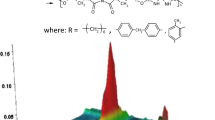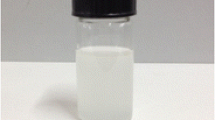Abstract
Amorphous polyurethanes (PUs) were prepared from isophorone diisocyanate and various diols based on ethylene glycol, containing phenol (PD), hydrogenated cardanol (HCD) and cardanol (CD) as side groups. The influence of side groups on thermal and thermo-oxidative stability was studied by thermogravimetric analysis and differential scanning calorimetry. The finding revealed that pendent C15 alkyl side groups of HCD–PU and CD–PU improved thermal stability of PUs. The possible crosslinks of olefinic side groups enhanced both thermal and thermo-oxidative stability of CD–PU. Both EG–PU and CD–PU exhibited good oxidative resistance. The glass transition temperature arranged in the order of EG–PU > PD–PU > HCD–PU > CD–PU. Cardanol molecules on PU backbones acted as an internal plasticizer and elevated the flexibility of PUs.











Similar content being viewed by others
References
Woods G (1987) The ICI polyurethanes book. Wiley, Chicester
Krol P (2007) Synthesis methods, chemical structures and phase structures of linear polyurethanes. Properties and applications of linear polyurethanes in polyurethane elastomers, copolymers and ionomers. Prog Mater Sci 52:915
Woebcken W (1995) Saechtling internation plastics handbook for the technologist, engineer. In: Haim J, Hyatt D (eds). Hanser, New York
Gandini A (2008) Polymers from renewable resources: a challenge for the future of macromolecular materials. Macromolecules 41:9491
Kumar PP, Paramashivappa R, Vithayathil PJ (2002) Process for isolation of cardanol from technical cashew (Anacardium occidentale L.) nut shell liquid. J Agric Food Chem 50:4705
Tyman JHP, Patel MS, Manzara AP (1982) Treatment of cashewnut shell liquid. US. Patent 4352944
Tyman JHP (1979) Practical liquid chromatographic separation of the phenols in technical cashew nutshell liquid from Anacardium occidentale. Chem Soc Rev 8:499
Mythili CV, Retna AM, Gopalakrishnan S (2004) Synthesis, mechanical, thermal and chemical properties of polyurethanes based on cardanol. Bull Mater Sci 27:235
Gopalakrishnan S, Fernando TL (2010) Processability and characteristics of novel polyurethanes from cardanol. Res J Pharm Bio Chem Sci 1:252
Suresh KI, Kishanprasad VS (2007) Process for preparing polyurethane polyol and rigid foams therefore. US. Patent 7244772 B2
Suresh KI, Kishanprasad VS (2005) Synthesis, structure and properties of novel polyols from cardanol and developed polyurethanes. Ind Eng Chem Res 44:4504
Rekha N, Asha SK (2008) Synthesis and FTIR spectroscopic investigation of the UV curing kinetics of telechelic urethane methacrylate crosslinkers based on the renewable resource-cardanol. J Appl Polym Sci 109:2781
Bhunia HP, Jana RN, Basak A, Lenka S, Nando GB (1998) Synthesis of polyurethane from cashew nut shell liquid (CNSL), a renewable resource. J Polym Sci A Polym Chem 36:391
Bhunia HP, Nando GB, Chaki TK, Basak A, Lenka S, Nayak PL (1999) Synthesis and characterization of polymers from cashew nut shell liquid (CNSL), a renewable resource II: synthesis of polyurethanes. Eur Polym J 35:1381
Risfaheri TT, Nur MA, Sailah I (2009) Isolation of cardanol from cashew nut shell liquid using the vacuum distillation method. Indones J Agric 2:11
Facanha MAR, Mazzetto SE, Carioca JOB, Barros GG (2007) Evaluation of antioxidant properties of a phosphorated cardanol compound on mineral oils (NH10 and NH20). Fuel 86:2416
Shahidi F (2005) Bailey’s industrial oil and fat products. Wiley, New York
Coates J (2000) Interpretation of infrared spectra, a practical approach: encyclopedia of analytical chemistry. Wiley, Chichester
Young RJ, Lovell PA (2009) Introduction to polymers. CRC Press, Florida, CR
Ionescu M (2005) Chemistry and technology of polyols for polyurethanes. Rapra technology, Shropshire
Athawale V, Shetty N (2010) Synthesis and characterization of low-cost cardanol polyurethanes. Pigment Resin Technol 39:9
Chattopadhyay DK, Webster DC (2009) Thermal stability and flame retardancy of polyurethanes. Prog Polym Sci 34:1068
Zhang Y, Xia Z, Huang H, Chen H (2009) Thermal degradation of polyurethane based on IPDI. J Anal Appl Pyrol 84:89
Sinha BR, O’Connor D, Blum FD (1989) Characterization of substituted phenol-formaldehyde resins using solid-state carbon-13 NMR. J Appl Polym Sci 38:163
Zubarev ER, Pralle MU, Li L, Stupp SL (1999) Conversion of supramolecular clusters to macromolecular object. Science 283:523
Richard C, Scacchi G, Back MH (1978) Ene reactions of olefins. I. The addition of ethylene to 2-butene and the decomposition of 3-methylpentene-1. Int J Chem Kinet 10:307
Gryn’ova G, Hodgson JL, Coote ML (2011) Revising the mechanism of polymer autooxidation. Org Biomol Chem 9:480
Perrin FX, Irigoyen M, Aragon E, Vernet JL (2000) Artificial aging of acrylurethane and alkyd paints: a micro-ATR spectroscopic study. Polym Degrad Stab 70:469
Dannoux A, Esnouf S, Amekraz B, Dauvois V, Moulin C (2008) Degradation mechanism of poly(ether-urethane) Estane® Induced by high-energy radation. II. Oxidation effects. J Polym Sci B Polym Phys 46:861
Gopalakrishnan S, Fernado TL (2011) Studies on aging performance of some novel polyurethanes. J Chem Pharm Res 3:848
Acknowledgments
The authors thank the Development Fund (64/2553) from Faculty of Engineering, Burapha University for financial support. SW would like to acknowledge Department of chemistry, Faculty of Science, Mahidol University. We also thank Dr. Jaray Jaratjaroonphong for his help and generous contributions of some laboratory equipment.
Author information
Authors and Affiliations
Corresponding author
Rights and permissions
About this article
Cite this article
Sakulsaknimitr, W., Wirasate, S., Pipatpanyanugoon, K. et al. Structure and Thermal Properties of Polyurethanes Synthesized from Cardanol Diol. J Polym Environ 23, 216–226 (2015). https://doi.org/10.1007/s10924-014-0707-2
Published:
Issue Date:
DOI: https://doi.org/10.1007/s10924-014-0707-2




